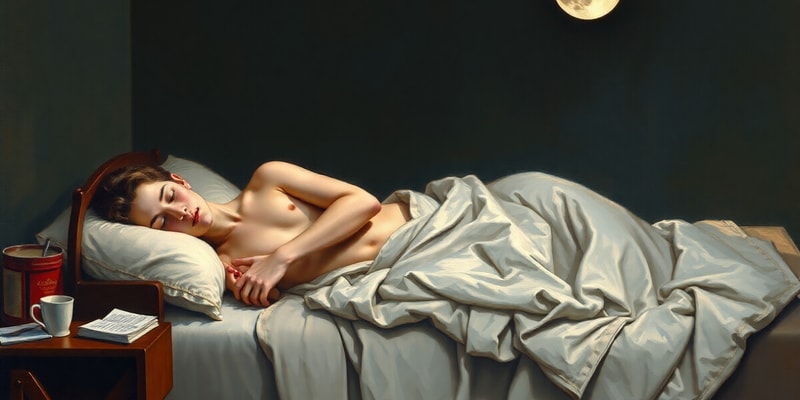Podcast
Questions and Answers
What does Process C in the two-process model of sleep-wake regulation refer to?
What does Process C in the two-process model of sleep-wake regulation refer to?
Which statement about caffeine's effect on the sleep process is true?
Which statement about caffeine's effect on the sleep process is true?
How does sleep architecture change from infancy to old age?
How does sleep architecture change from infancy to old age?
At what age is sleep typically characterized by monophasic sleep patterns?
At what age is sleep typically characterized by monophasic sleep patterns?
Signup and view all the answers
Which age group is associated with the highest amount of slow wave sleep?
Which age group is associated with the highest amount of slow wave sleep?
Signup and view all the answers
What is the theoretical maximum build-up of Process S in the context of sleep deprivation?
What is the theoretical maximum build-up of Process S in the context of sleep deprivation?
Signup and view all the answers
Which famous inventor famously used napping as a tool for enhancing creativity?
Which famous inventor famously used napping as a tool for enhancing creativity?
Signup and view all the answers
Which of the following describes the trend in REM and NREM sleep from infancy to early childhood?
Which of the following describes the trend in REM and NREM sleep from infancy to early childhood?
Signup and view all the answers
What occurs to the wake:REM:NREM ratio as people age from 20 to 90 years?
What occurs to the wake:REM:NREM ratio as people age from 20 to 90 years?
Signup and view all the answers
Study Notes
Two Process Model of Sleep-Wake Regulation
- Process C: Circadian Rhythm, our drive to be awake. As Process C increases, our drive to be awake increases.
-
Process S: Homeostatic Sleep Drive, the time elapsed since last awake and the drive to sleep. This is driven by adenosine buildup.
- The longer we are awake, the greater the pressure to sleep.
- Adenosine decreases as we sleep, returning Process S to baseline.
- Caffeine can block the adenosine signal, masking Process S.
- The greater the urge to sleep is, the greater the distance between Process S and Process C.
-
Sleep Deprivation:
- Feeling bad at 4-5 am: Process C at its lowest, Process S high.
- Feeling better at around 11 am: Process C starts to increase.
- Feeling bad at 11 pm: Large gap between Process C and S, leading to oversleeping the next day, and a return of Process S to baseline.
- Process S could continue building forever.
Sleep Ontogeny
- Sleep pattern changes throughout life:
- Newborn: highly polyphasic sleep (no consistent day/night structure).
- 1 year old: polyphasic sleep.
- 4 years old: biphasic sleep.
- 10 years old: monophasic sleep.
- Adult: monophasic sleep, but shorter sleep period.
-
Wake:REM:NREM Ratio Changes:
- 20-90 years old: decreasing total sleep (40-50 years), stable 4NREM1:REM ratio.
- Infant: 1:1 REM:NREM ratio, 8 hours of each.
- 1-2 Years: total NREM increases, REM decreases.
- 2-20 Years: decrease in total sleep.
-
Sleep Architecture Changes:
-
Child (~7 years):
- Greater slow wave sleep.
- Few awakenings.
- More REM sleep.
- Young Adult (~25 years): Mostly deep sleep/NREM in the first half of the night, then mostly REM in the second half.
-
Elderly (~75 years):
- Absence of slow wave sleep.
- Increased awakenings.
- Reduced REM sleep.
-
Child (~7 years):
Creativity
-
Societal Anecdotes:
- Paul McCartney's "Yesterday" came to him in a dream.
- Thomas Edison, an inventor, was a habitual napper, using naps as a creativity tool.
-
The Genius Gap:
- Diet dreams: using sleep as a tool for creativity.
-
Examples in Science:
- Mendeleev attributed his discovery of the periodic table to a dream.
-
Empirical, Scientific Studies:
- Numeric number reduction task: tested if people could see trends in number strings and find a faster rule for solving them.
- REM sleep or dream sleep showed significant benefits in problem solving.
- The power of "sleeping on it" for problem solving transcends cultural boundaries.
- 3-fold increase in problem-solving after sleep.
Studying That Suits You
Use AI to generate personalized quizzes and flashcards to suit your learning preferences.
Description
Explore the intricate dynamics of the Two Process Model governing sleep-wake regulation. This quiz covers the roles of Circadian Rhythm (Process C) and Homeostatic Sleep Drive (Process S), along with their interactions, effects of sleep deprivation, and factors like caffeine. Test your knowledge on how these processes impact our sleep patterns.




